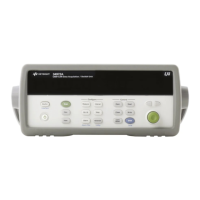Tutorial 7
Keysight 34970A/34972A User’s Guide 309
Normal Strain (ε) is a measure of the
deformation along the axis of the
applied force. ε = ΔL/L
Shearing Strain (γ) is a measure of
the angular distortion of a body. It is
approximated by the tangent of the
angle formed by the angular change
between two line segments that
were parallel in the undeformed
state.
Poisson Strain (ν) measures a
property of materials known as the
Poisson Ratio. It is the negative ratio
of transverse and longitudinal
normal strain when a body has a
longitudinal tensile force applied. ν
= -ε
t
/ε, where
ε
t
= ΔD/D and ε = ΔL/L
Stress
Stress is a term used to compare the loading applied to a material with its ability
to carry the load. Stress (σ) in a material
can not be measured directly; it must be computed from material properties and
measurable quantities such as strain and force.
Strain Sensors
The metal foil resistance strain gage is by far the most widely used strain
measurement sensor. It consists of a thin metallic foil grid bonded to a thin
insulating, adhesive backing. The resistance of the foil varies linearly with strain.
Strain in the test body is simply the ratio of the foil’s strained to unstrained
resistance: ε = ΔR / R.
The Gage Factor (GF) indicates the sensitivity of a strain gage and is a measure of
the fractional resistance change per strain: GF = (ΔR / R) / ε. Devices with a higher
gage factor will exhibit a greater resistance change per strain applied.
γ
D -ΔD
FF
F
Force
(F)
Force
(F)
L + ΔL
L + ΔL

